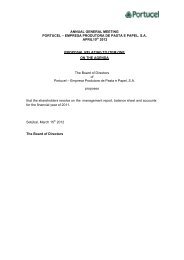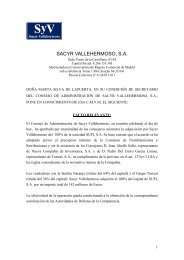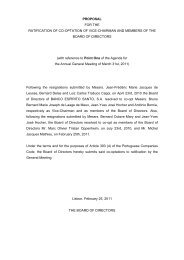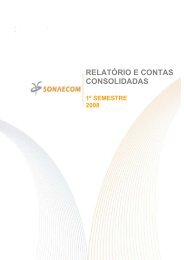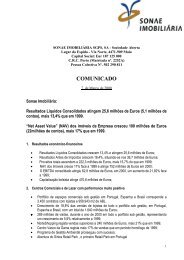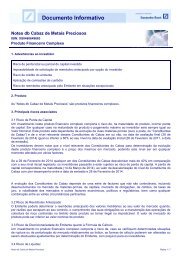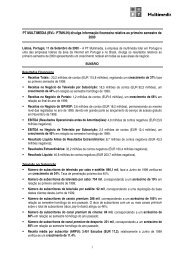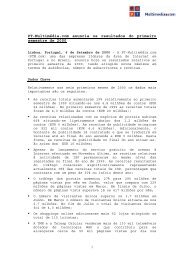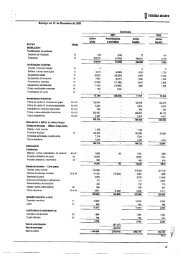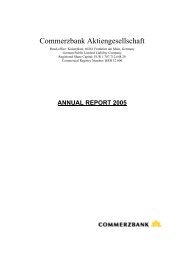edp – energias de portugal, sa edp finance bv €12500000000 - CMVM
edp – energias de portugal, sa edp finance bv €12500000000 - CMVM
edp – energias de portugal, sa edp finance bv €12500000000 - CMVM
Create successful ePaper yourself
Turn your PDF publications into a flip-book with our unique Google optimized e-Paper software.
The increase of competition in electricity and natural gas supply in liberalised markets in the Iberian<br />
Peninsula may reduce EDP’s margins and reduce its ability to sell electricity and natural gas to value-ad<strong>de</strong>d<br />
final customers.<br />
All electricity consumers in Portugal have been free to choose their electricity supplier since 2006. After<br />
2008, the liberalised markets increased consi<strong>de</strong>rably. In June 2011, accumulated electricity consumption in the<br />
liberalised market represented about 45 per cent. of total consumption. EDP maintained its leading position in<br />
the liberalised market, with a cumulative total consumption representing 41 per cent. of the total liberalised<br />
market. EDP operates as the “last resort” supplier in the Portuguese electricity supply business through EDP<br />
Serviço Univer<strong>sa</strong>l, S.A. and acts as a common supplier in the liberalised market through EDP Comercial <strong>–</strong><br />
Comercialização <strong>de</strong> Energia, S.A.<br />
All natural gas consumers in Portugal have been free to choose their gas supplier since the beginning of<br />
2010. In June 2011, EDP has a cumulative total consumption representing 33 per cent. of the total liberalised<br />
market. EDP operates as the “last resort” supplier in <strong>de</strong>termined areas of Portugal through EDP Gás Servico<br />
Univer<strong>sa</strong>l. S.A. and acts as a common supplier in the liberalised market through EDP Gás. Com-Comércio <strong>de</strong> Gás<br />
Natural S.A. In Spain, retail tariffs for electricity were phased out in June 2009, and substituted by a last resort<br />
tariff system. Thus, since 1 July 2009, last resort consumers (low-voltage consumers whose contracted power is<br />
less than or equal to 10 kw) have been able to choose between their last resort supplier and several common<br />
suppliers in the liberalised market. All other consumers are supplied in the liberalised market. EDP’s subsidiary<br />
HC Energia is the last resort supplier of electricity in the Asturias region. Gas retail tariffs no longer exist in<br />
Spain, meaning that gas customers are able to choose between their last resort supplier and several common<br />
suppliers in the liberalised market. EDP’s subsidiary Naturgas is the last resort supplier of gas in the Basque<br />
Country and Asturias region. In the future, more competing suppliers are expected to enter the market and<br />
engage in electricity <strong>sa</strong>les. The effects of this increased competition could materially and adversely affect EDP’s<br />
<strong>sa</strong>les of electricity.<br />
The implementation by Portugal and Spain of EU directives that are inten<strong>de</strong>d to create competitive electricity<br />
and natural gas supply markets; for instance, the limitation of certain large clients’ access to the last resort<br />
tariffs or the increase of competitiveness in such markets could have a material adverse effect on EDP’s<br />
business, financial condition, prospects or results of operations. In July 2010, the Portuguese government<br />
announced that high-, medium- and special low-voltage clients will no longer be able to benefit from electricity<br />
regulated tariffs. These clients were transferred to the free market on 1 January 2011 in compliance with EU<br />
directives on electricity tariffs, while last resort tariffs will continue to be applicable to low-voltage customers<br />
(mainly households and small businesses).<br />
In addition, EDP cannot anticipate the various risks and opportunities that may arise from the ongoing<br />
liberali<strong>sa</strong>tion in the Iberian Peninsula’s electricity and natural gas markets. The complete implementation of<br />
the liberali<strong>sa</strong>tion process, with the end of regulated retail tariffs, the eventual end of the role of last resort<br />
suppliers, and the resulting competition could have a material adverse effect on EDP’s business, financial<br />
condition, prospects or results of operations.<br />
EDP’s renewable activities in the United States may be adversely affected by changes in current renewable<br />
support schemes or the failure of such support to materialise due to adverse market conditions.<br />
In the United States, the fe<strong>de</strong>ral government currently supports renewable energy primarily through tax<br />
incentives and a grant program to reimburse a portion of eligible capital costs. In addition, many state<br />
governments have implemented Renewable Portfolio Standards (“RPS”) that typically require that, by a<br />
specified date, a certain percentage of a utility’s electricity supplied to consumers within such state is to be<br />
from renewable sources. Historically, the main tax incentives have been the fe<strong>de</strong>ral production tax credit<br />
(“PTC”) and the five-year <strong>de</strong>preciation for eligible assets un<strong>de</strong>r the Modified Accelerated Cost Recovery System<br />
(“MACRS”). In February 2009, a new U.S. fe<strong>de</strong>ral law allowed renewable energy projects that forego PTCs to<br />
elect an investment tax credit (“ITC”), or a cash grant equal to 30 per cent. of the capital invested in the project.<br />
Un<strong>de</strong>r the new law, renewable energy projects placed in service before the end of 2012 can choose among the<br />
PTC, ITC or cash grant, although only projects that begin construction before the end of 2010 will be eligible for<br />
the cash grant. The PTC legislation was first enacted in 1992 and has historically been exten<strong>de</strong>d by the U.S.<br />
Congress for one- to four-year periods. While in the past the PTC has consistently been exten<strong>de</strong>d, it has been<br />
allowed to expire three times before being subsequently exten<strong>de</strong>d, thereby creating a lapse period. In each<br />
case, the U.S. Congress applied the PTC retroactively to cover such lapse period; however the periodic<br />
expiration and uncertainty of the legislative process with respect to extensions affected industry participants.<br />
No comparable legislative history exists for the ITC or grant program since they were not options for wind<br />
20



